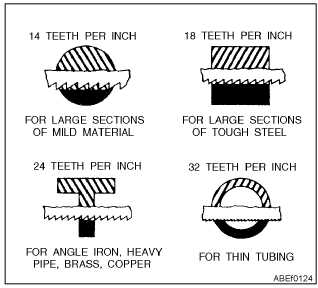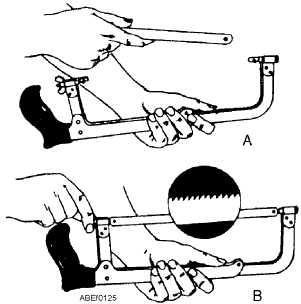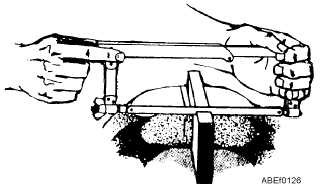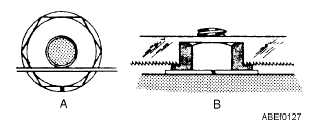selection of the blades for the work to be done. Figure
1-14 will help you select the proper blade to use when
sawing metal with a hacksaw. Coarse blades, with
fewer teeth per inch, cut faster and are less likely to
choke up with chips. However, finer blades, with more
teeth per inch, are necessary when thin sections are
being cut. The selection should be made so that, as each
tooth starts its cut, the tooth ahead of it will still be
cutting.
To make the cut, first install the blade in the
hacksaw frame (fig. 1-15) so the teeth point away from
the handle of the hacksaw. (Hand hacksaws cut on the
push stroke.) Tighten the wingnut until the blade is
definitely under tension. This helps make straight cuts.
Place the material to be cut in a vise. A minimum of
overhang will reduce vibration, give a better cut, and
lengthen the life of the blade. Have the layout line
outside of the vise jaw so that the line is visible while
you work.
The proper method of holding the hacksaw is
depicted in figure 1-16. See how the index finger of the
right hand, pointed forward, aids in guiding the frame.
When cutting, let your body sway ahead and back
with each stroke. Apply pressure on the forward stroke,
which is the cutting stroke, but not on the return stroke.
From 40 to 50 strokes per minute is the usual speed.
Long, slow, steady strokes are preferred.
For long cuts, rotate the blade in the frame so that
the length of the cut is not limited by the depth of the
frame. Hold the work with the layout line close to the
vise jaws, raising the work in the vise as the sawing
proceeds.
To remove a frozen nut with a hacksaw, saw into the
nut, as shown in figure 1-17, starting the blade close to
the threads on the bolt or stud and parallel to one face of
the nut, as shown in view A. Saw parallel to the bolt
until the teeth of the blade almost reach the lockwasher.
Lockwashers are hard and will ruin hacksaw blades, so
do not try to saw them. View B shows when to stop
sawing. Then, with a cold chisel and hammer, remove
this one side of the nut completely by opening the saw
1-12
Figure 1-14.—Selecting the proper hacksaw blade.
Figure 1-15.—Installing a hacksaw blade.
Figure 1-16.—Proper way to hold a hacksaw.
Figure 1-17.—Removing a frozen nut with a hacksaw.







